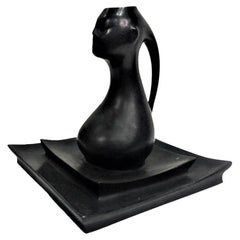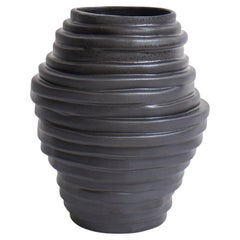Alfonso Canciani Decorative Objects
1
to
1
1
1
1
1
1
1
1
Height
to
Width
to
1
1
1
1
1
1,313
745
505
450
Creator: Alfonso Canciani
Alfonso Canciani, Viennese Secession Orientalist Bronze Vase, c. 1910
By Alfonso Canciani
Located in New York, NY
Alfonso Canciani (Italian-Austrian, 1863-1955) was a famous Italian-Austrian sculptor of the period of accession to the Viennese Secession. Son of a stonemason, after a realist period he managed to establish himself as a leading sculptor of the Viennese Secession. In fact, he worked in Vienna, where he had enrolled in 1886 at the Academy of Fine Arts, then at the Higher School of Sculpture and finally at the Special School, where he obtained the Rome prize for the sketch for Dante's Monument.
He developed a notable business obtaining important prizes and numerous commissions. First among the sculptors of the Viennese capital, he was invited to join the Association of the Viennese Secession, of which Klimt was magna pars, after the exhibition of Dante's group in 1900 at the Secession exhibition, and obtained the most important Austrian artistic prize, the Kunstlerlpreis.
This same work, presented in 1910 in Berlin, at the Great Art Exhibition, also received an important recognition here. He obtained the Rome prize in 1896, exhibited successfully in Munich and in 1899 at the III International Art Exhibition in Venice.
In that period he made some statues of saints for the cathedral of Santo Stefano in Vienna, the monument to Wagner, the bust of Nietzsche for the University, the scepter and the gold chain of the University Rector, figures of Italian poets ( Petrarch, Boccaccio, Tasso, Ariosto).
He submitted a sketch for the official monument to Empress Elizabeth, which was then built in Austrisn Gföhl and Pula. At the time of his accession to the Secession, he dedicated himself to decorating the facade of the Artaria house in Vienna in collaboration with the architect Max Fabiani.
He later abandoned the symbolist decorativism of the Jugendstil for a more concentrated and vigorous style, approaching the Belgian sculptor Constantin Meunier for the theme of work, and preferring to exhibit at the Künstlerhaus.
In Vienna, he was generous with advice and help with the Italians and in particular with his fellow citizens (such as the Brazzanese Luigi Visintin, then a university student).
After the First World War, he returned to Italy and lived in Friuli, penalized by the fact that the Habsburg Empire had by now disappeared. Instead of large-scale public monuments, he then devoted himself to engraving medals (e.g. for Benedict XV and for the Italian mission in Vienna in 1919) and to designing funeral monuments (examples in Mali Lošinj and Trieste) and portrait busts (of Generals Carlo Caneva and Antonio Baldissera in Udine, sculptures of the War Memorial of Corno di Rosazzo). After all, he had already executed the Bab grave monument in the Döblinger cemetery in Vienna in 1909.
He taught in Trieste from 1920 until 1935, at the local school of industrial art, where he had Marcello Mascherini...
Category
1910s Austrian Jugendstil Vintage Alfonso Canciani Decorative Objects
Materials
Bronze
Related Items
Alfonso Vase, by Project 213A
By Project 213A
Located in Macieira de Sarnes, PT
This vase draws inspiration from the Icelandic volcanic rock formations which can be found by Reynisfjara Black Sand Beach. It is sculpted by organically displacing seventeen individ...
Category
21st Century and Contemporary Portuguese Modern Alfonso Canciani Decorative Objects
Materials
Clay
Alfonso Vase, by Project 213A
By Project 213A
Located in Macieira de Sarnes, PT
This vase draws inspiration from the Icelandic volcanic rock formations which can be found by Reynisfjara Black Sand Beach. It his sculpted by organically displacing seventeen indivi...
Category
21st Century and Contemporary Portuguese Modern Alfonso Canciani Decorative Objects
Materials
Clay
Alfonso Vase, by Project 213A
By Project 213A
Located in Macieira de Sarnes, PT
This vase draws inspiration from the Icelandic volcanic rock formations which can be found by Reynisfjara Black Sand Beach. It his sculpted by organically displacing seventeen indivi...
Category
21st Century and Contemporary Portuguese Modern Alfonso Canciani Decorative Objects
Materials
Clay
Vienna Secession glazed earthenware vase, Austria, ca. 1902
By Josef Hoffmann
Located in EVERDINGEN, NL
A large octagonal green glazed earthenware vase with blue glazed squares, marked Austria and numbered 7143. These type of vases were made in the Vienna School of Applied Arts (Wiener...
Category
Early 1900s Austrian Vienna Secession Antique Alfonso Canciani Decorative Objects
Materials
Earthenware
Free Shipping
H 13.78 in W 5.91 in D 5.91 in
French Ceramic Vase, Cauterets, Conical Vase, France, circa 1910
Located in Copenhagen, DK
French ceramic vase, Cauterets.
Signed. Conical vase, blue-gray glaze running on beige-brown ground, France, circa 1910.
Heights: 17 cm.
In perfect c...
Category
1910s French Art Nouveau Vintage Alfonso Canciani Decorative Objects
Kralik Fish Scales Vase, circa 1910
By Wilhelm Kralik Sohn
Located in Tunbridge Wells, GB
Kralik Fish Scales Vase, circa 1910
Additional Information:
Date: c1910
Origin: Bohemia
Bowl Features: Iridescent glass in a fish scale pattern, ...
Category
20th Century Czech Jugendstil Alfonso Canciani Decorative Objects
Materials
Glass, Art Glass, Blown Glass
Pair of Secession Vases by Lajos Mack for Zsolnay
By Zsolnay, Lajos Mack
Located in Chicago, US
Zsolnay introduced its patented shiny metallic glaze, known as eosin, in 1893. The small family ceramics workshop begun in Pecs, Hungary by Miklos Zsolnay in 1853 had evolved into a ...
Category
1890s Hungarian Art Nouveau Antique Alfonso Canciani Decorative Objects
Materials
Earthenware
Julius Mulhaus or Hermann Pautsch Decorated Jugendstil Vase, circa 1910
By Julius Muhlhaus & Co. Haida 1
Located in Tunbridge Wells, GB
Julius Mulhaus or Hermann Pautsch Decorated Jugendstil Vase, circa 1910
Additional Information:
Date: circa 1910
Origin: Bohemia
Bowl Features: Richly gilded and enamelled wit...
Category
20th Century Czech Jugendstil Alfonso Canciani Decorative Objects
Materials
Glass
Jugendstil Glass Vase with Holder by Argentor Vienna Around 1910
Located in Wien, AT
Jugendstil glass vase with holder by Argentor vienna around 1910
Polished and stove enameled
Original cut glass.
Category
1910s Austrian Jugendstil Vintage Alfonso Canciani Decorative Objects
Materials
Brass
Viennese Orientalist Cold-Painted Bronze Figurative Lamp
Located in London, GB
Viennese Orientalist cold-painted bronze figurative lamp
Austrian, c. 1910
Measures: Height 36cm, width 13cm, depth 16cm
This fine bronze l...
Category
Early 20th Century Austrian Alfonso Canciani Decorative Objects
Materials
Bronze
Benedict Studios Arts & Crafts Bronze Bud Vase, Circa 1910
By Benedict Manufacturing Co. 1
Located in South Bend, IN
A gorgeous Arts & Crafts period bronze bud vase with an emblem of a classical Greek figure
By Benedict Studios (signed to the underside)
USA, Circa 1910
Measures: 3.25"W x 3.25"D ...
Category
Early 20th Century American Arts and Crafts Alfonso Canciani Decorative Objects
Materials
Bronze
Art Nouveau Jugendstil Large Bronze Mounted Porcelain Vase
Located in Richmond Hill, ON
Incredible Large Vase. Bronze Mounted, refined porcelain glaze.
Underside of the base has a number and maybe a stamp.
Decorative and refined vase.
Size: 19.5 inches x 5 inches diam...
Category
Early 1900s Austrian Jugendstil Antique Alfonso Canciani Decorative Objects
Materials
Porcelain
Alfonso Canciani decorative objects for sale on 1stDibs.
Alfonso Canciani decorative objects are available for sale on 1stDibs. These distinctive items are frequently made of metal and are designed with extraordinary care. There are many options to choose from in our collection of Alfonso Canciani decorative objects, although gold editions of this piece are particularly popular. Many of the original decorative objects by Alfonso Canciani were created in the Art Nouveau style in europe during the 1910s. If you’re looking for additional options, many customers also consider decorative objects by Koloman Moser, Gustav Gurschner, and K.K. Kunst-Erzgiesserei Wien. Prices for Alfonso Canciani decorative objects can differ depending upon size, time period and other attributes — on 1stDibs, these items begin at $3,600 and can go as high as $3,600, while a piece like these, on average, fetch $3,600.


